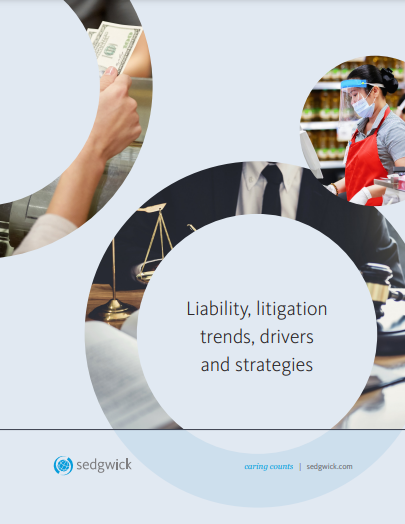In May 2020, Sedgwick published an analysis of liability claims litigation trends and practices.
When that analysis was being published, the world became entrenched in the COVID pandemic that over the course of the last two years has had a tremendous impact on practically all aspects of our lives; it has been described as an emotional roller coaster creating skepticism in many things, institutions and even people that prior to the pandemic seemed irrefutable. How this translates into the future of liability litigation, social inflation and jury deliberations remains to be seen.
Due to many factors, trends indicate very little if any change to the key findings noted in our May 2020 publication. Litigation rates and costs continue to rise with a primary influencer with the continued increase in the number of claims that have attorney involvement at first notice of loss.
The COVID-19 pandemic temporarily muted the effects of many aspects of liability litigation. However, social inflation and nuclear verdicts continue to impact the industry with growth in the number and value of awards.
Considering the liability litigation environment, litigation avoidance at the claim stage must continue to be a focus. First and foremost, companies must cultivate a culture that emphasizes safe and responsible practices and processes supporting their commitment to environmental, social, and governance objectives. Yet claims will occur and when they do tactics such as advocacy and timely communication with a focus on claim resolution will help ensure that claims do not become litigated. Further, utilization of predictive modeling can help identify litigation prone claims where alternative workflows can be implemented to focus on prevention and resolution.
Once a suit is at hand, companies should focus on employing strategies and tactics to reach an amicable pre-trial settlement, where appropriate. When this is not appropriate or available, specific trial tactics to: humanize the corporate defendant; counter the “reptile theory” typically employed by plaintiff’s counsel; and “anchoring” to provide alternative values for jury consideration.
Given the substantial impact that the growing subset of claims that are litigated equates to and the indications that litigated claims are becoming more frequent, companies and their insurers are well served to allocate additional attention and resources to these claims and to identifying means and methods to avoid or mitigate them.
The pandemic and other world events have created unrest and uncertainty, and change continues in 2022. Uncertainty and unrest are a recipe for dispute in an already increasingly litigious environment. However, change also brings opportunity. While indicators continue to suggest that the size of verdicts and even nuclear verdicts may continue to increase for the foreseeable future, insurers and their customers can collaboratively develop effective strategies to avoid and mitigate litigation and its costs. A better understanding of the challenges and deliberate planning chart the path to more predictable outcomes.
Click here to view or download the full commentary paper by Chris Frechette, vice president, liability practice and Max Koonce, chief claims officer.

